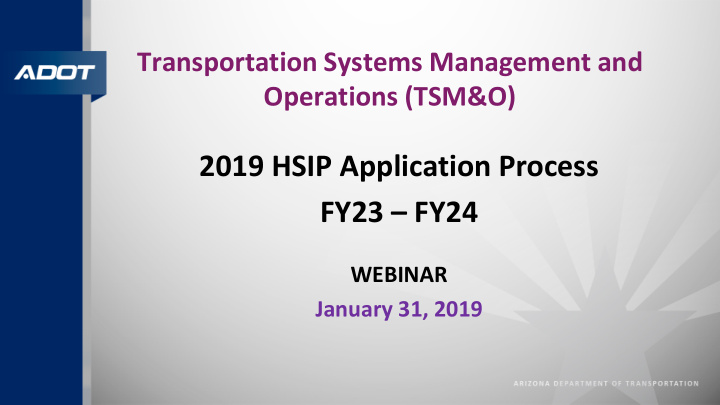



Transportation Systems Management and Operations (TSM&O) 2019 HSIP Application Process FY23 – FY24 WEBINAR January 31, 2019
Highway Safety Improvement Program HSIP Goal • The goal of the HSIP is to achieve a significant reduction in traffic fatalities and serious injuries on all public roads. • It is intended to drive State HSIP investment decisions by ensuring projects correspond to the emphasis areas and strategies identified in the SHSP.
HSIP Governance The HSIP is legislated under Section 148 of Title 23, United States Code (23 U.S.C. 148) and regulated under Part 924 of Title 23, Code of Federal Regulations (23 CFR Part 924). The HSIP consists of three main components, the Strategic Highway Safety Plan (SHSP), State HSIP or program of highway safety improvement projects and the Railway-Highway Crossing Program (RHCP).
FY21-FY22 Initial vs Final Applications Initial Submittal Local Applications, 35 which = $ 34,013,706 or 30.2% State Applications, 35 which = $78,676,664 or 69.8% Total Applications, 70 which = $112,690,370 After Eligibility Review Local Applications, 34 which = $32,802,888 or 38.1% State Applications, 29 which = $53,476,733 or 61.9% Total Applications, 62 which = $86,279,621 All estimates do not include local/state matches or other funds.
Ranking Criteria • Overall list based on the B/C ratio of each project • Systemic projects limited to 20% of available HSIP funding by SFY
FY 21 - FY22 Combined Projects Funded by Number & Dollars Number Dollars Total 47 $56,810,561.00 Local 31 $24,394,086.00 State 16 $32,416,475.00 Total HSIP Funds Available = $56,520,000.00
B/C Ratio Range High was 56.6 – Project was Rumble Strips Low was 3.9 – Install a Median Barrier
Crash History vs Project Project Crashes Non-Infrastructure Pedestrian $1,300,000.00, $14,411,448.00, 1.8% Pedestrian 20.0% Wrong Way 2598, 12.3% 40, 0.2% Intersection 8,909, 42.1% Intersection $10,378,696.00, Roadway/Lane 14.4% $31,198,343.00, Roadway/Lane Departure 43.3% 7,011, 33.2% Wrong Way Other $6,889,794.00, 9.6% 2,580, 12.2% Speed $7,822,074.00, 10.9%
Lessons Learned • Submitting application to TSS for review prior to final submittal pays off • Don’t underestimate the scope or cost of a project • Each countermeasure has to meet the B/C ratio requirement • No lump sum cost estimates • Make sure the existing support structure can accommodate new countermeasure
HSIP Funds Available in FY23 & FY24 $35 Million for each year
ADOT HSIP Manual Appendix A – Project Application Process and Worksheets Appendix B – Crash Modification Factors Appendix C – Project Service Life Appendix D – Acquisition of Construction and Highway Safety Equipment (AzTraCS IT Equipment Only) (Pending Approval)
HSIP Essentials Appendix A to HSIP Excel Workbook – 14 Tabs HSIP Manual
Documentation Required for HSIP Application (Appendix A) 1. Transmittal Letter (Tab 3) 2. HSIP Application (Tab 2) 3. Cost Estimate (Tab 4–9) 4. B/C Ratio Analysis (Tab 10) 5. State Location Map 6. Work Limits Map 7. Copy of Warrant (If required)
HSIP Application (Tab 2)
CMF vs CRF A crash modification factor (CMF) is a multiplicative factor used to compute the expected number of crashes after implementing a given countermeasure at a specific site. A crash reduction factor (CRF) is the percentage crash reduction that might be expected after implementing a given countermeasure at a specific site. So, what do I use in my Benefit to Cost (B/C) ratio analysis? CRF
Where Do I Find CRFs? Tabs 11. & 12. of the ADOT HSIP excel Application has 4 and 5 star CMFs CMF Countermeasure Countermeasure Study Title Resource Countermeasure CRF CMF Crash Type ID Category Subcategory Safety Evaluation of Improved Click for Install chevron signs on Non- 2438 Curve Delineation CMF details Signs horizontal curves 16 0.84 intersection FHWA Crash Modification Clearing House http://www.cmfclearinghouse.org/
Where Do I Find CRFs? (Continued) CMF Appendix B – ADOT HSIP Manual
HSIP Cost Estimate
Most recent 5-year average of crashes counter- measure will influence Don’t mix CMF and CRF up Increased From Cost Estimate Tab From Appendix C, HSIP Manual Best estimate Increased to ≥ 2.5
Changes to FY23 – FY24 HSIP Program • Select information technology system equipment can be purchased for new AZTraCS implementation. The $250,000.00 minimum project cost is lowered to $5,000.00 for these projects. (Currently, this funding is on-hold until final ADOT management approval.) • HSIP funds can be used for yearly licensing fees for statewide crash data software with ADOT approval • The comprehensive unit costs for fatal and serious injury crashes have increased in the B/C ratio calculation sheet (Due to statewide actuarial adjustment) ($9,515,371 for fatal crashes and $550,499 for IC crashes)
Changes to FY23 – FY24 HSIP Program (Continued) • The minimum B/C ratio increases to ≥ 2.5 (Due to increased actuarial adjustments) • An inflation factor of 5% has been added to Cost Estimate Tabs to account for estimated inflation between project selection and 2023 (This is only an estimate and ADOT takes no responsibility for ultimate accuracy. Individual agencies may select higher inflationary estimates.) • Total project costs for non-infrastructure projects, i.e. SHSPs, RSAs, licensing fees, etc. are capped at 5% of the yearly SFY HSIP available funds.
HSIP Flow Chart
Key Dates • May 3, 2019 – Final HSIP applications due to TSS • April 1, 2019 ADOT HSIP Applications submitted • July 2019 - HSIP Safety Committee Meeting • October 4, 2019 – All eligibility letters issued
Link for HSIP Manual & Application https://www.azdot.gov/business/tsmo/operational-and- traffic-safety/arizona-highway-safety-improvement-program
Thank You! Traffic Safety Section: Kerry Wilcoxon, P.E., PTOE Kwilcoxon@azdot.gov 602-712-2060 Mona Aglan-Swick, P.E. Maglan-swick@azdot.gov 602-712-7374 Larry Talley Ltalley@azdot.gov 602-712-7709
Recommend
More recommend